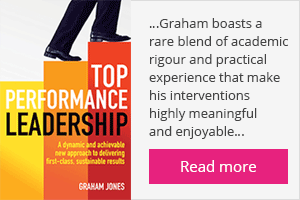I hope you’ve had a good couple of weeks. Mine have mainly involved running workshops and coaching lawyers.
Last week I recorded a podcast on ‘real leadership and mental toughness’ for the American Management Association (AMA) in New York. This will be available on the AMA, Lane4, and this website very shortly.
I also discovered that there is at least one person out there who reads my blog! A huge thank you to Dr. Sue Hybart who emailed me some questions all the way from Cardiff University in the UK. Sue has given me permission to respond to the questions in this public forum. So here it goes.
Sue: Do the companies you work with involve you in the selection processes for leadership positions? If so, does this extend beyond recruitment and into succession planning?
Graham: I haven’t been involved formally in leadership selection processes but I have been asked frequently about what companies should be assessing when recruiting new leaders. Despite knowing better, organizations still make the mistake of using criteria related almost exclusively to functional expertise rather than leadership capability. And I believe that this is also true in the case of succession planning. They then find themselves having to bring in people like myself and Lane4 to coach and run workshops for their newly-appointed leaders on how to lead people! And this situation will only be exacerbated as the ‘new normal’ unfolds and even more demands are imposed on leaders – there really will be no hiding place for any leader in the ‘new normal’! This is where the distinction between real and safe leaders is so important. Organizations must recruit and promote real leaders who possess a strong capability to deal with the pressures that accompany the role. This will not be achieved until organizations first prioritize the need and then find and implement ways and means of evaluating this crucial leadership requirement.
Sue: Am I right in thinking that your coaching work includes turning safe leaders into real leaders, and keeping real leaders on track?
Graham: It’s important to view real and safe leadership at the extremes of a continuum. The more senior the leader, the more towards the real end s/he should be operating at. As ever, it’s not as simple as being one or the other. Occasionally, a safer leadership approach is required when the stakes are particularly high. So I try to coach flexibility and adaptability in leaders to enable them to move along the continuum. You’re right, however, in that my overall aim is to develop real leaders.
Sue: How does an organization stop allowing safe leaders to perpetuate the status quo and hinder progress and innovation?
Graham: Great question. Traditionally, this has been very difficult to achieve. But I do believe that the ‘new normal’ will bring with it opportunities that leave organizations with no option but to recognize and seize in order to tackle this problem. For example, companies should emphasize and make a big show of rewarding innovation instead of merely paying lip-service to it. They should create environments which encourage calculated risks and tolerate responsible mistakes if they are to embrace true innovation. And most organizations with a preponderance of safe leaders do not operate an effective feedback system and process. If they do have one, then it probably generates feedback on transactional performance rather than on leadership capability. In a previous career, when I was an academic working in the same environment as yourself Sue, I only received feedback on my lecturing ability via student evaluation and on my research capability via my publication list. My team were never asked to provide feedback on my leadership. My guess is that’s probably still the case. But there’s a relatively easy way to change this in academia and every other profession and industry!
I was delighted to receive the email from Sue, and it would be great to hear from you all, whether it be questions, comments, anything you like – that is printable of course!
Have a good next couple of weeks.

